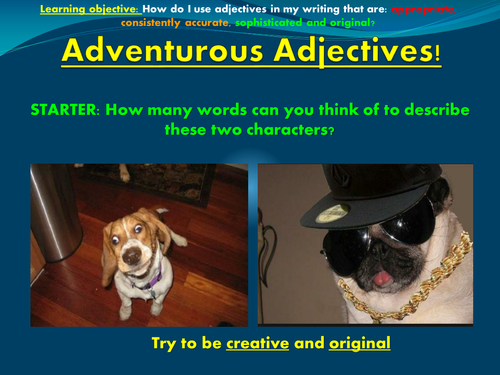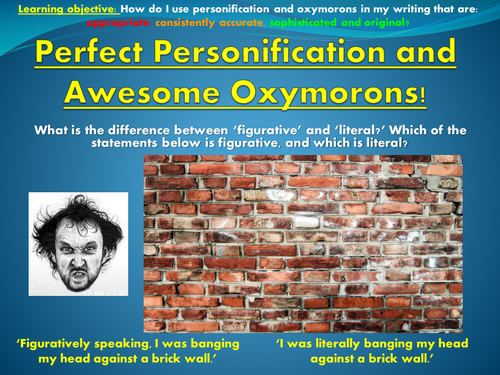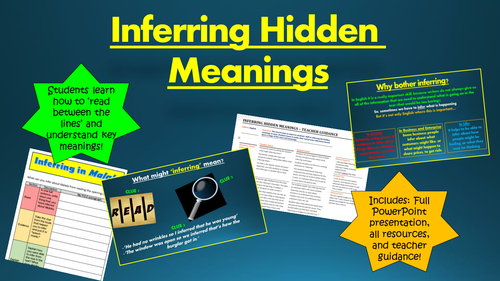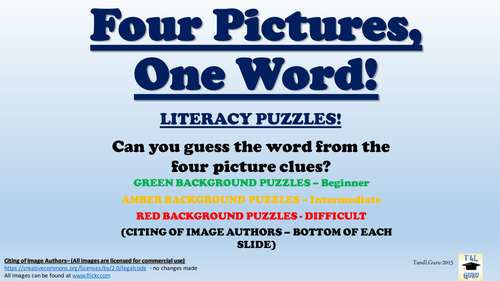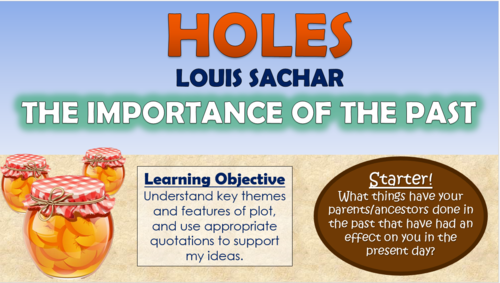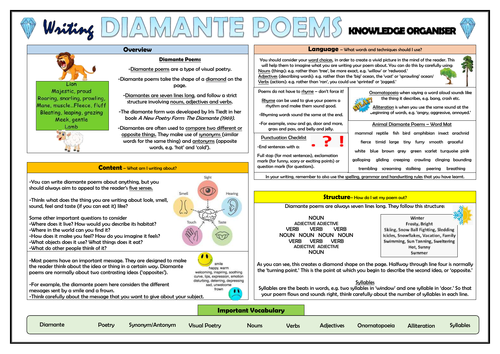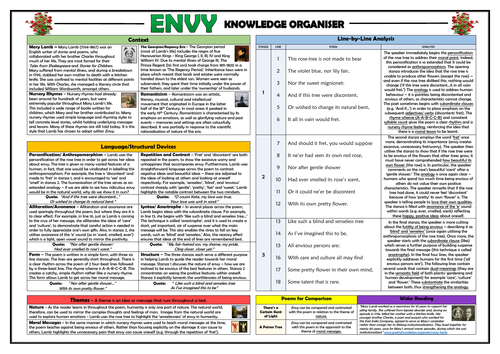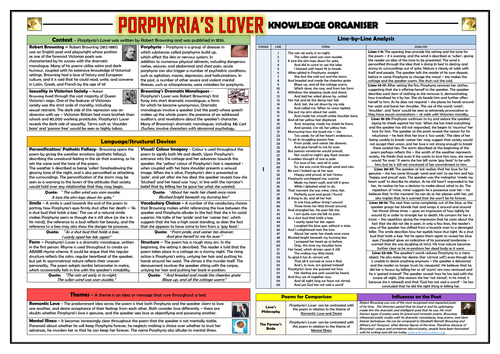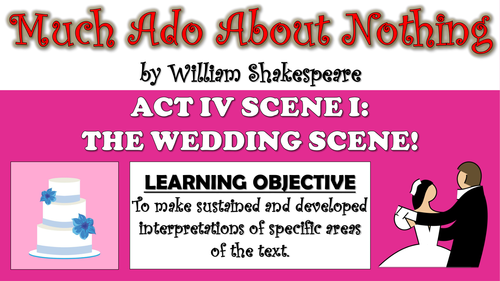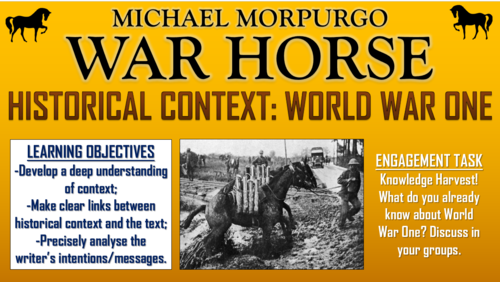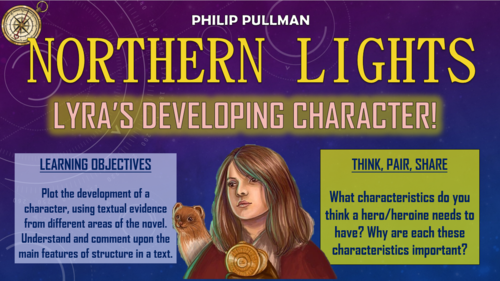
3k+Uploads
1925k+Views
2250k+Downloads
English

Adventurous Adjectives!
This is an exciting and engaging lesson/set of tasks aiming to build students' skills at using personification and adjectives in their writing . It was taught during an observation lesson where the teacher received an Outstanding judgement.
Students learn to:
- Define and give examples of what regular, adventurous, comparative, and superlative adjectives are;
- Identify adjectives in fun and interesting examples;
- Analyse what makes them effective;
- Create their own adventurous adjectives using step-by-step advice;
- Peer assess using a clear and succinct success criteria.
It comes complete with:
- Engaging and visual PowerPoint to guide students (and teacher!) through the lesson;
- Colourful and thought-provoking worksheet for the main analysis task;
- Lesson plan/ teacher guidance sheet, which goes through the lesson step-by-step;
- Resources to create adjective word cards.
All pictures are licensed for commercial use, and image authors cited on the final slide.
This lesson can also be bought as part of the Descriptive Devices bundle for just £5. The bundle leads students through each language device needed in order to write to describe confidently.
Alternatively, you can buy the Descriptive Writing Big Bundle (All descriptive devices lessons, structuring and organising writing lesson, capturing the readers attention lesson, and the literacy writing mat) for £6

Perfect Personification and Awesome Oxymorons!
This is an exciting and engaging lesson/set of tasks aiming to build students' skills at using personification and oxymorons in their writing . It was taught during an observation lesson where the teacher received an Outstanding judgement.
Students learn to:
- Define and give examples of what personification and oxymorons are;
- Identify personification and oxymorons in fun and interesting examples;
- Analyse what makes them effective;
- Create their own personification and oxymorons using step-by-step advice;
- Peer assess using a clear and succinct success criteria.
It comes complete with:
- Engaging and visual PowerPoint to guide students (and teacher!) through the lesson;
- Colourful and thought-provoking two-part worksheet for the two main create tasks;
- Lesson plan/ teacher guidance sheet, which goes through the lesson step-by-step;
All pictures are licensed for commercial use, and image authors cited on the final slide.
This lesson can also be bought as part of the Descriptive Devices bundle for just £5. The bundle leads students through each language device needed in order to write to describe confidently.
Alternatively, you can buy the Descriptive Writing Big Bundle (All descriptive devices lessons, structuring and organising writing lesson, capturing the readers attention lesson, and the literacy writing mat) for £6.

Inferring the Hidden Meanings in Texts
This lesson enables students to 'read between the lines' in texts and infer significant meanings. Utilising a range of visual, kinaesthetic, and reading tasks, students not only gain an increased understanding of the importance of inference in English, but also gain an awareness of its importance in other areas of life.
The lesson follows an interesting and engaging step-by-step learning journey, which helps students to:
- Define what inference is;
- Understand the importance of inference;
- Infer what they can see;
- Infer what they hear;
- Infer what they read, using key sentence starters and textual evidence;
- Formulate P.E.E. inference responses, where necessary utilising the included scaffolds and help-sheets;
- Peer/self assess their learning attempts.
Included in this resource pack:
- Full whole-lesson PowerPoint presentation;
- P.E.E scaffold sheet;
-Writing to analyse helpsheet;
- Pictures required for development task;
- Teacher guidance
All images are licensed for commercial use, and are cited on the final slide.

Four Pictures, One Word!
This is a great resource for lesson starters, building literacy across the curriculum, plenaries, or simply for fun. Based upon the popular mobile app, this visually engaging activity is highly effective at promoting engagement and getting students thinking about words - many of whom seem to love playing the game on their phones! It is particularly useful for Literacy practitioners who are looking to expand students' vocabularies and/or raise the subject of homonyms.
There are a range of challenges:
Green = Beginner level
Amber= Intermediate level
Red = Expert level
The document is easily editable, so you can also add in your own pictures and challenges. Also, all of the pictures used are licensed for commercial use, and all authors are cited.

Holes - The Importance of the Past!
This engaging and informative lesson helps students to understand one of the main recurring themes in Louis Sachar’s Holes: The effect of the past upon the present. Students study several of the flashbacks in Sachar’s non-linear narrative, and establish how different objects, ideas, and settings are evidence of the links between past and present at Camp Green Lake.
The lesson follows a step-by-step learning journey, in which children learn through:
- Reading and understanding the selected extracts to comprehend how past and present events are linked at Camp Green Lake;
- Exploring different objects and ideas, such as the spiced peaches and the treasure, to demonstrate how different sub-plots are interwoven;
- Using textual evidence to show a deeper understanding of the writer's purpose in linking the features of past and present together;
- Analysing how the effect of the past becomes an effective theme throughout the story;
- Peer assessing each other's learning attempts;
Included is:
- Whole lesson PowerPoint - colourful and comprehensive;
- 'Text Detectives' worksheet - (PDF and Word versions);
- Selected extract - Chapter 7;
- Essay template for analytical paragraphs;
- Comprehensive lesson plan.
There are also opportunities for group learning, speaking and listening, peer assessment, and whole class discussion. I originally used these resources with year 7 and 8 classes, however colleagues have used them for between years 4 and 9 with minimal adaptations.
All images are licensed for commercial use, and image rights are listed on the last page of the presentation.

Writing Shape Poems - KS1 Knowledge Organiser!
This clear, detailed and visually-appealing resource offers a complete reference point for KS1 children when writing shape poems. The organiser is also perfect for teachers, parents and English subject leaders - aiding their planning and supporting of children’s knowledge development for this writing text type.
The organiser has a particular focus on the content, language and structural features required to write effective shape poems at KS1. It contains distinct sections covering:
-Overview: Shape poems;
-Content: What to include, the five senses, communicating a message;
-Language: Word choices, similes and alliteration, rhyme, punctuation checklist and word mat;
-Structure: Line lengths, syllables, Top tips;
-Key Vocabulary.
The content is fully aligned with the age-related expectations for KS1 children in writing. The resource is designed to be printed onto A3, and is provided as both a PDF and a Word version (so that you can edit if you want to). All images used are licensed for commercial use and are cited on a separate document (included).

Writing Diamante Poems - Knowledge Organiser!
This clear, detailed and visually-appealing resource offers a complete reference point for children when writing diamante poems. The organiser is also perfect for teachers, parents and English subject leaders - aiding their planning and supporting of children’s knowledge development for this writing text type.
The organiser has a particular focus on the content, language and structural features required to write effective diamante poems. It contains distinct sections covering:
-Overview: Diamante poems;
-Content: What to include, the five senses, communicating a message;
-Language: Word choices, word types, alliteration and onomatopoeia, punctuation checklist and word mat;
-Structure: Word structure, line lengths, syllables, Top tips;
-Key Vocabulary.
The resource was originally designed for KS1/ lower KS2 children. It is designed to be printed onto A3 (however can also be printed in A4) and is provided as both a PDF and a Word version (so that you can edit if you want to).

Envy - Mary Lamb - Knowledge Organiser/ Revision Mat!
This detailed and visually-appealing resource offers a complete reference point for students learning or revising Mary Lamb’s poem 'Envy.’ It contains comprehensive sections on:
Context;
Line-by-Line Analysis;
Poetic Devices/ Language Devices;
Themes;
Form/Structure;
Poems for Comparison;
Links to Wider Reading.
Key words and ideas are underlined for easy reference. The resource is designed to be printed onto A3, and is provided as both a PDF and a Word version (so that you can edit if you want to). All images used are licensed for commercial use and are cited on a separate document (included).

Catrin Knowledge Organiser/ Revision Mat!
This detailed and visually-appealing resource offers a complete reference point for students learning or revising Gillian Clarke’s power and conflict poem 'Catrin.’ It contains comprehensive sections on:
Context;
Line-by-Line Analysis;
Poetic Devices/ Language Devices;
Themes;
Form/Structure;
Poems for Comparison;
The Poet’s Influences.
Key words and ideas are underlined for easy reference. The resource is designed to be printed onto A3, and is provided as both a PDF and a Word version (so that you can edit if you want to). All images used are licensed for commercial use and are cited on a separate document (included).

My Last Duchess - Robert Browning - Comprehension Activities Booklet!
This 16-page resource booklet contains a wide range of challenging and engaging comprehension activities for use throughout the reading of Robert Browning’s power and conflict poem 'My Last Duchess.’ Teachers have found the activities particularly useful throughout teaching, or for exam revision or guided reading sessions. They are perfect for aiding the progress of students towards meeting the key English Literature assessment objectives - suitable for all examining bodies. Students have found these resources extremely engaging, and it is clearly highlighted within each task regarding which assessment strands the task is designed to demonstrate.
It is provided in both Word (to allow for easy editing) and PDF (to ensure for consistency of formatting between computers).
Activities within the booklet include (amongst many others):
‘Analysing Context’ - helping students to ‘Show understanding of the relationships between texts and the contexts in which they were written.’
‘Analysing Subject Matter, Language and Structure’ - to help students to ‘Analyse the language, form and structure used by a writer to create meanings and effects, using relevant subject terminology where appropriate.’
‘Diary Entry’ - to help students to ‘Use a range of vocabulary and sentence structures for clarity, purpose and effect, with accurate spelling and punctuation. Make an informed personal response, recognising that other responses to a text are possible and evaluating these.’
‘The Speaker’ - to help students to ‘Read, understand and respond to texts. Students should be able to: maintain a critical style and develop an informed personal response use textual references, including quotations, to support and illustrate interpretations.’

Porphyria's Lover Knowledge Organiser/ Revision Mat!
This detailed and visually-appealing resource offers a complete reference point for students learning or revising Robert Browning’s love and relationships poem 'Porphyria’s Lover.’ It contains comprehensive sections on:
Context;
Line-by-Line Analysis;
Poetic Devices/ Language Devices;
Themes;
Form/Structure;
Poems for Comparison;
The Poet’s Influences.
Key words and ideas are underlined for easy reference. The resource is designed to be printed onto A3, and is provided as both a PDF and a Word version (so that you can edit if you want to). All images used are licensed for commercial use and are cited on a separate document (included).

Ancient Egypt Non-Fiction Text - Whole Class Reading Session!
This whole class reading session aims to develop children’s comprehension skills through a reading of a non-fiction text about Ancient Egypt.
The resource pack includes the full text and all of the activities for the session, which the class are guided through via a comprehensive PowerPoint presentation. The reading is followed by a series of activities aiming to develop children’s retrieval, explanation, inference, prediction and summarising skills. It also contains a vocabulary check immediately after the extract is read to clarify any unfamiliar/ difficult language.
The tasks are comprised of quick-check questions, solo thinking, pair/ group discussions and deeper thinking activities.
The text is originally sourced from an age-appropriate version of Britannica, and includes details on Ancient Egyptian history, geography, housing, clothing, religion, and a number of other important information categories.
The session is best suited for children in lower KS2, although with minor adaptations it could feasibly be used with slightly older or younger year groups. This resource is suitable for home/ remote learning. These resources are also suitable for home/ remote learning.

War Horse - Whole Class Reading Session!
This whole class reading session aims to develop children’s comprehension skills through a reading of the opening chapter of Michael Morpurgo’s ‘War Horse.’
The resource pack includes the extract and all of the activities for the session, which the class are guided through via a comprehensive PowerPoint presentation. The reading is followed by a series of activities aiming to develop children’s retrieval, explanation, inference, prediction and summarising skills. It also contains a vocabulary check immediately after the extract is read to clarify any unfamiliar/ difficult language.
The tasks are comprised of quick-check questions, solo thinking, pair/ group discussions and deeper thinking activities.
The session is best suited for children in Year 5 and 6, but it could feasibly be used with slightly younger and older year groups. The session is also suitable for home/ remote learning.

Sylvia Plath - You're - Knowledge Organiser!
This detailed and visually-appealing resource offers a complete reference point for students learning or revising Sylvia Plath’s poem ‘You’re.’ It contains comprehensive sections on:
Context;
Line-by-Line Analysis;
Poetic Devices/ Language Devices;
Themes;
Form/Structure;
Poems for Comparison;
More About the Poem.
Key words and ideas are underlined for easy reference. The resource is designed to be printed onto A3, and is provided as both a PDF and a Word version (so that you can edit if you want to). All images used are licensed for commercial use and are cited on a separate document (included).

Traction Man is Here - Knowledge Organiser/ Revision Mat!
This detailed and visually-appealing resource offers a complete reference point for students learning or revising Mini’ Grey’s ‘Traction Man is Here.’ It contains comprehensive sections on:
Context;
Story Summary;
Main Characters;
Themes;
Writing Techniques;
Important Vocabulary.
Key words and ideas are underlined for easy reference. The resource is designed to be printed onto A3, and is provided as both a PDF and a Word version (so that you can edit if you want to). All images used are licensed for commercial use and are cited on a separate document (included).

My Heart Leaps Up - William Wordsworth - Comprehension Activities Booklet!
This 16-page resource booklet contains a wide range of challenging and engaging comprehension activities for use throughout the reading of William Wordsworth’s poem 'My Heart Leaps Up.’ The tasks draw on English Literature assessment objectives - suitable for all examining bodies - clearly highlighted within each task.
The booklet is provided in both Word (to allow for easy editing) and PDF (to ensure for consistency of formatting between computers).
Activities within the booklet include (amongst many others):
‘Analysing Context’ - helping students to ‘Show understanding of the relationships between texts and the contexts in which they were written.’
‘Analysing Subject Matter, Language and Structure’ - to help students to ‘Analyse the language, form and structure used by a writer to create meanings and effects, using relevant subject terminology where appropriate.’
‘Diary Entry’ - to help students to ‘Use a range of vocabulary and sentence structures for clarity, purpose and effect, with accurate spelling and punctuation. Make an informed personal response, recognising that other responses to a text are possible and evaluating these.’
‘The Speaker’ - to help students to ‘Read, understand and respond to texts. Students should be able to: maintain a critical style and develop an informed personal response use textual references, including quotations, to support and illustrate interpretations.’

Much Ado About Nothing - Act IV Scene I - The Wedding Scene!
This engaging, in-depth lesson enables students to understand how the plot events in the wedding scene create a sense of climax throughout Act IV Scene I of Much Ado About Nothing. In particular, the lesson focuses upon the language used by Claudio and Leonato to denounce Hero (with links to the expectations within the social/historical context of the renaissance), the dramatic response to the allegations, and Benedick's altering priorities.
The lesson follows a step-by-step learning journey, in which students learn through:
- Identifying the key events of the plot leading up to the wedding scene.
- Reading and comprehending the predominant plot events in Act IV Scene I.
- Understanding the idea of the patriarchal family society, and considering the accusations directed at Hero in light of this.
- Completing an essay style response in which they consider how the key plot events contribute to a sense of climax within the scene.
- Peer assessing each other's learning attempts.
Included is:
- Whole lesson PowerPoint - colourful and detailed - just download and teach from it!
- Cards for card-sorting activity;
- Wedding Scene worksheet (and teacher answer sheet);
- Analysis template with success criteria for creating well-structured responses;
- Comprehensive lesson plan.

Great White Sharks Non-Fiction Text - Whole Class Reading Session!
This whole class reading session aims to develop children’s comprehension skills when reading non-fiction texts. This particular session focuses on their reading of an original information sheet (included) about Great White Sharks.
The reading is followed by a series of activities aiming to develop children’s retrieval, explanation, inference, prediction and summarising skills. It also contains a vocabulary check immediately after the extract is read to clarify any unfamiliar/ difficult language.
The tasks are comprised of quick-check questions, solo thinking, pair/ group discussions and deeper thinking activities.
The session is best suited for children in years 2-4, although with minor adaptations it could feasibly be used with slightly younger and older year groups.

War Horse - Historical Context: World War One!
This engaging and informative lesson enables students to understand the key features of the historical context of World War I, in order to gain a clearer of understanding of Michael Morpurgo’s War Horse. In particular, students learn about the key features of World War I (including the role of horses) before linking their understanding of historical context to different extracts from the text. Finally, they analyse Morpurgo’s key intentions/messages in including such ideas within his novel.
The lesson follows a step-by-step learning journey, in which children learn through:
Researching and understanding key information about World War I, including how it was initiated, the role of horses, life in the trenches, and going ‘over the top;’
Linking the key features of context to sections of the text;
Reading selected extracts from the text, in order to link ideas regarding context and text together;
Analysing Morpurgo’s key messages and ideas in through his depiction of the historical context;
Creating their own anti-war propaganda posters, detailing what war was really like for young soldiers;
Peer assessing each other’s learning attempts;
Included is:
Whole lesson PowerPoint - colourful and comprehensive;
Research Template;
Selected extracts (from chapters 2, 4, 7 and 8);
Essay template
Comprehensive lesson plan.
There are also opportunities for group learning, speaking and listening, peer assessment, and whole class discussion. I originally used these resources with year 7 and 8 classes, however colleagues have used them for between year 4 (advanced) and year 9 with minimal adaptations.
Please note that students will need internet access for the research introduction task.
All images are licensed for commercial use, and image rights are listed on the last page of the presentation.

Northern Lights - Lyra's Developing Character!
This engaging and informative lesson enables students to understand how the lead protagonist of Philip Pullmans’s Northern Lights, Lyra, develops as a character and as a heroine throughout the narrative. In doing so, students learn the key features of heroes and heroines, and apply these to the different behaviours that Lyra exhibits over the course of the novel. They then go on to design their own hero/heroine development storyboards!
The lesson follows a step-by-step learning journey, in which children learn through:
-Defining what heroes and heroines are, and identifying their key features;
-Comprehending how Lyra is initially introduced to the reader, using an extract from the text;
-Tracking Lyra’s development as a hero over the course of the novel, using a development graph and justification table;
-Creating a storyboard for their own heroic journey, using the template provided;
Self assessing their learning attempts.
Included is:
Whole lesson PowerPoint - colourful and comprehensive;
Extract from Chapter 1 of Northern Lights;
Lyra’s development tracking template;
Create your own Bildungsroman novel storyboard template;
Comprehensive lesson plan.
All resources are provided in Word (for easy editing) and PDF (to ensure formatting remains fixed between different computers).
There are also opportunities for group learning, speaking and listening, peer assessment, and whole class discussion. I originally used these resources with year 7/8 classes, however colleagues have used them for between years 5 and 10 with some adaptations.
All images are licensed for commercial use, and image rights are listed on the last page of the presentation.

